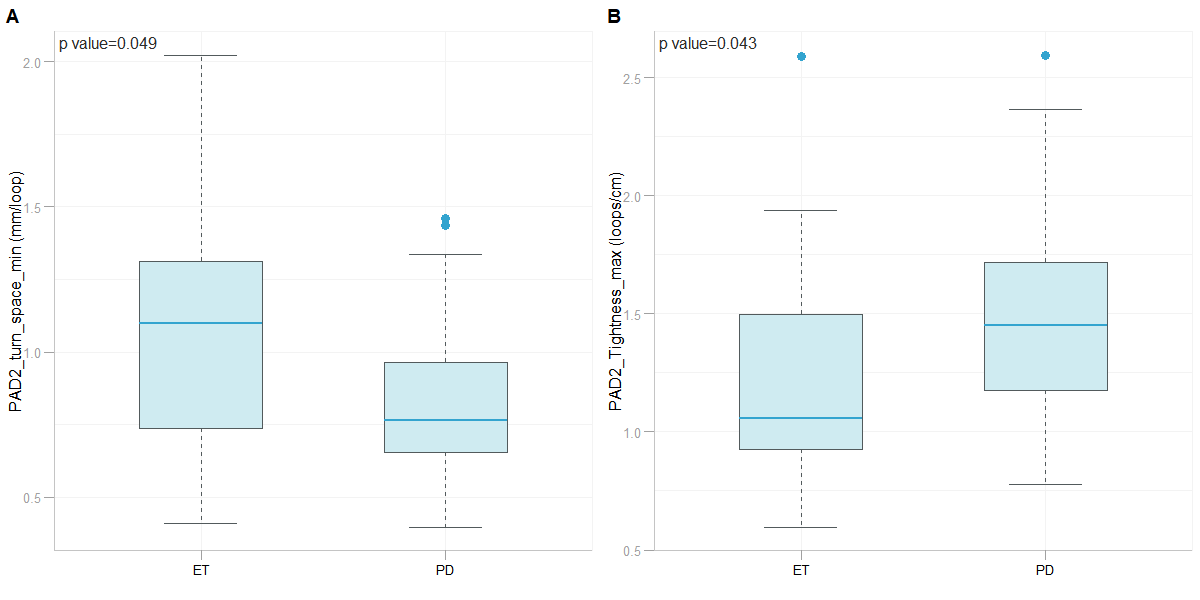Category: Tremor
Objective: To discriminate PD from ET via machine learning using drawing features calculated from raw signal data obtained from digital assessment system.
Background: Precise discrimination between PD and ET is challenging since they have some overlapping clinical features, such as tremor. Handwriting task has proven to be a useful diagnostic tool in tremor disorders. However, it is challenge for clinicians to integrate all this simultaneous visual information during the examination in order to classify tremor. Since iPad could capture precise, hand-drawn digital data to analyze movement disorder[1], we could use iPad as a digital assessment tool to differentiate PD from ET.
Method: This study involved 93 participants (PD: 53, ET: 40) who had hand tremor symptoms. They were asked to complete 6 different drawing tasks with iPad. Their Apple pencil drawing trajectory was recorded to compute a series of time and frequency domain features, such as pressure difference, velocity. The dataset was randomly split into training (80%) and independent test data (20%). Several models were trained and compared to discriminate between PD and ET. Final model was evaluated on independent test data.
Results: Random Forest was selected as our final model as its cross-validation performance [accuracy 85.1%, Kappa 0.694, Sensitivity 90.5%, Specificity 78.1%, AUC_ROC 0.901] outperformed other models. The 13 features for this final model construction were all related to pressure difference, velocity, jerkiness, peak frequency and latitude. The independent test data achieved 89.5% accuracy. For the feature analysis, our result show that PD has lower pen tip pressure difference than ET, which means that PD have more consistent pen tip pressure compared to ET. Additionally, our result shows that PAD2_turn_space_min (i.e.calculated as the the largest radius of the spiral to the number of spiral loops ) was smaller in PD than ET by 29.1% on average, and Tightness was higher in PD than ET by 36.9% on average (Figure 1), which were consistent with previous finding – Participants with PD usually drew tighter and smaller spiral compared to participants with ET[2].
Conclusion: Our findings suggest that features extracted from drawing tasks combined with machine learning had the potential to discriminate between PD and ET.
spiral polar features
References: 1. Sisti JA, Christophe B, Seville AR, Garton ALA, Gupta VP, Bandin AJ, et al. Computerized spiral analysis using the iPad. Journal of Neuroscience Methods. 2017;275:50-4.DOI: 10.1016/j.jneumeth.2016.11.004
2. Alty J, Cosgrove J, Thorpe D, Kempster P. How to use pen and paper tasks to aid tremor diagnosis in the clinic. Practical Neurology. 2017;17(6):456-63.DOI: 10.1136/practneurol-2017-001719
To cite this abstract in AMA style:
Z. Liu, SN. Lin, XM. Wang, Z. Wang, F. Zhang, Y. Ling, K. Ren, ZL. Chen, T. Feng. Utilizing a tablet-based digital drawing to discriminate Parkinson’s disease from essential tremor [abstract]. Mov Disord. 2024; 39 (suppl 1). https://www.mdsabstracts.org/abstract/utilizing-a-tablet-based-digital-drawing-to-discriminate-parkinsons-disease-from-essential-tremor/. Accessed January 1, 2026.« Back to 2024 International Congress
MDS Abstracts - https://www.mdsabstracts.org/abstract/utilizing-a-tablet-based-digital-drawing-to-discriminate-parkinsons-disease-from-essential-tremor/

